Final Essay: Critical Analysis of Phone Records in Adnan Syed's Case
VerifiedAdded on 2022/11/07
|5
|1325
|103
Essay
AI Summary
This essay provides a critical analysis of the Adnan Syed case, focusing on the reliability of the phone records and witness testimony presented during the trial. The essay examines the evidence against Syed, including the testimony of Jay Wild and the cell phone data, and evaluates its consistency and credibility. It also explores the impact of the Serial podcast on the case, highlighting how the podcast raised doubts about the evidence and the fairness of the trial. The analysis considers the arguments of both the prosecution and the defense, drawing on academic sources and the Serial podcast to assess the strengths and weaknesses of the evidence. Ultimately, the essay examines the role of evidence in the case and the potential for alternative interpretations, with the Maryland State Court of Appeals' decision as a reference point. The essay concludes by discussing the complexities of the case and the ongoing debate surrounding Syed's guilt or innocence.
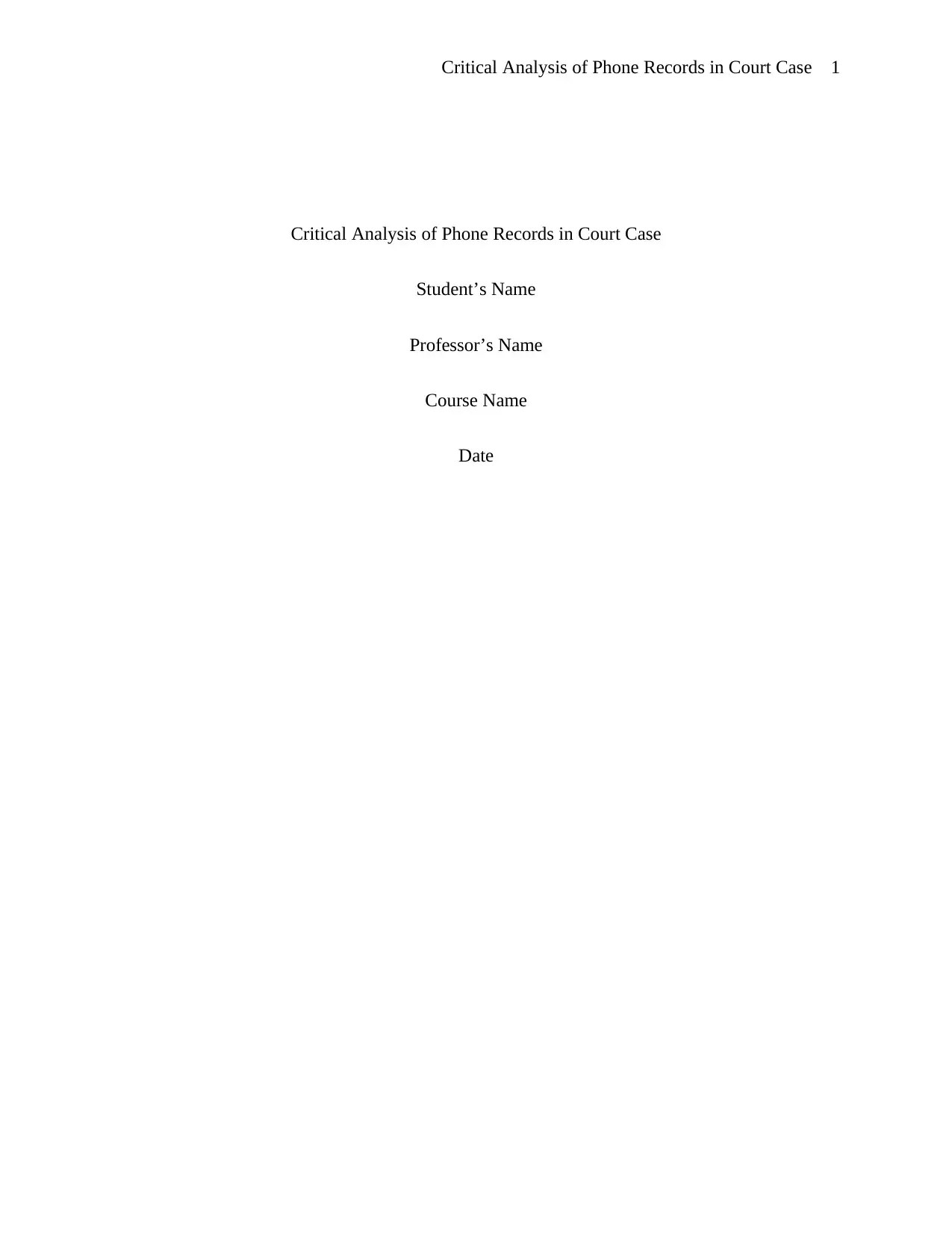
Critical Analysis of Phone Records in Court Case 1
Critical Analysis of Phone Records in Court Case
Student’s Name
Professor’s Name
Course Name
Date
Critical Analysis of Phone Records in Court Case
Student’s Name
Professor’s Name
Course Name
Date
Paraphrase This Document
Need a fresh take? Get an instant paraphrase of this document with our AI Paraphraser
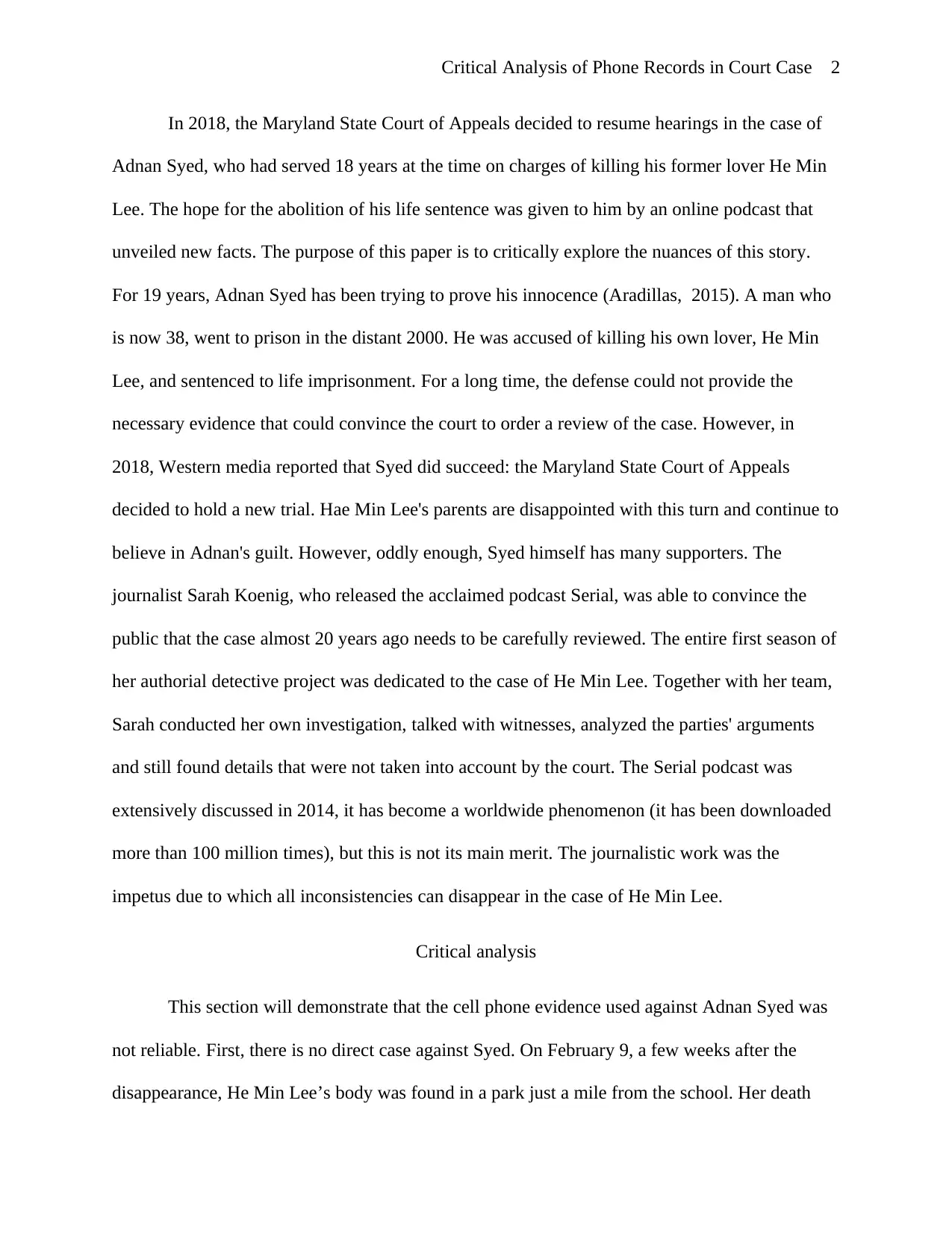
Critical Analysis of Phone Records in Court Case 2
In 2018, the Maryland State Court of Appeals decided to resume hearings in the case of
Adnan Syed, who had served 18 years at the time on charges of killing his former lover He Min
Lee. The hope for the abolition of his life sentence was given to him by an online podcast that
unveiled new facts. The purpose of this paper is to critically explore the nuances of this story.
For 19 years, Adnan Syed has been trying to prove his innocence (Aradillas, 2015). A man who
is now 38, went to prison in the distant 2000. He was accused of killing his own lover, He Min
Lee, and sentenced to life imprisonment. For a long time, the defense could not provide the
necessary evidence that could convince the court to order a review of the case. However, in
2018, Western media reported that Syed did succeed: the Maryland State Court of Appeals
decided to hold a new trial. Hae Min Lee's parents are disappointed with this turn and continue to
believe in Adnan's guilt. However, oddly enough, Syed himself has many supporters. The
journalist Sarah Koenig, who released the acclaimed podcast Serial, was able to convince the
public that the case almost 20 years ago needs to be carefully reviewed. The entire first season of
her authorial detective project was dedicated to the case of He Min Lee. Together with her team,
Sarah conducted her own investigation, talked with witnesses, analyzed the parties' arguments
and still found details that were not taken into account by the court. The Serial podcast was
extensively discussed in 2014, it has become a worldwide phenomenon (it has been downloaded
more than 100 million times), but this is not its main merit. The journalistic work was the
impetus due to which all inconsistencies can disappear in the case of He Min Lee.
Critical analysis
This section will demonstrate that the cell phone evidence used against Adnan Syed was
not reliable. First, there is no direct case against Syed. On February 9, a few weeks after the
disappearance, He Min Lee’s body was found in a park just a mile from the school. Her death
In 2018, the Maryland State Court of Appeals decided to resume hearings in the case of
Adnan Syed, who had served 18 years at the time on charges of killing his former lover He Min
Lee. The hope for the abolition of his life sentence was given to him by an online podcast that
unveiled new facts. The purpose of this paper is to critically explore the nuances of this story.
For 19 years, Adnan Syed has been trying to prove his innocence (Aradillas, 2015). A man who
is now 38, went to prison in the distant 2000. He was accused of killing his own lover, He Min
Lee, and sentenced to life imprisonment. For a long time, the defense could not provide the
necessary evidence that could convince the court to order a review of the case. However, in
2018, Western media reported that Syed did succeed: the Maryland State Court of Appeals
decided to hold a new trial. Hae Min Lee's parents are disappointed with this turn and continue to
believe in Adnan's guilt. However, oddly enough, Syed himself has many supporters. The
journalist Sarah Koenig, who released the acclaimed podcast Serial, was able to convince the
public that the case almost 20 years ago needs to be carefully reviewed. The entire first season of
her authorial detective project was dedicated to the case of He Min Lee. Together with her team,
Sarah conducted her own investigation, talked with witnesses, analyzed the parties' arguments
and still found details that were not taken into account by the court. The Serial podcast was
extensively discussed in 2014, it has become a worldwide phenomenon (it has been downloaded
more than 100 million times), but this is not its main merit. The journalistic work was the
impetus due to which all inconsistencies can disappear in the case of He Min Lee.
Critical analysis
This section will demonstrate that the cell phone evidence used against Adnan Syed was
not reliable. First, there is no direct case against Syed. On February 9, a few weeks after the
disappearance, He Min Lee’s body was found in a park just a mile from the school. Her death
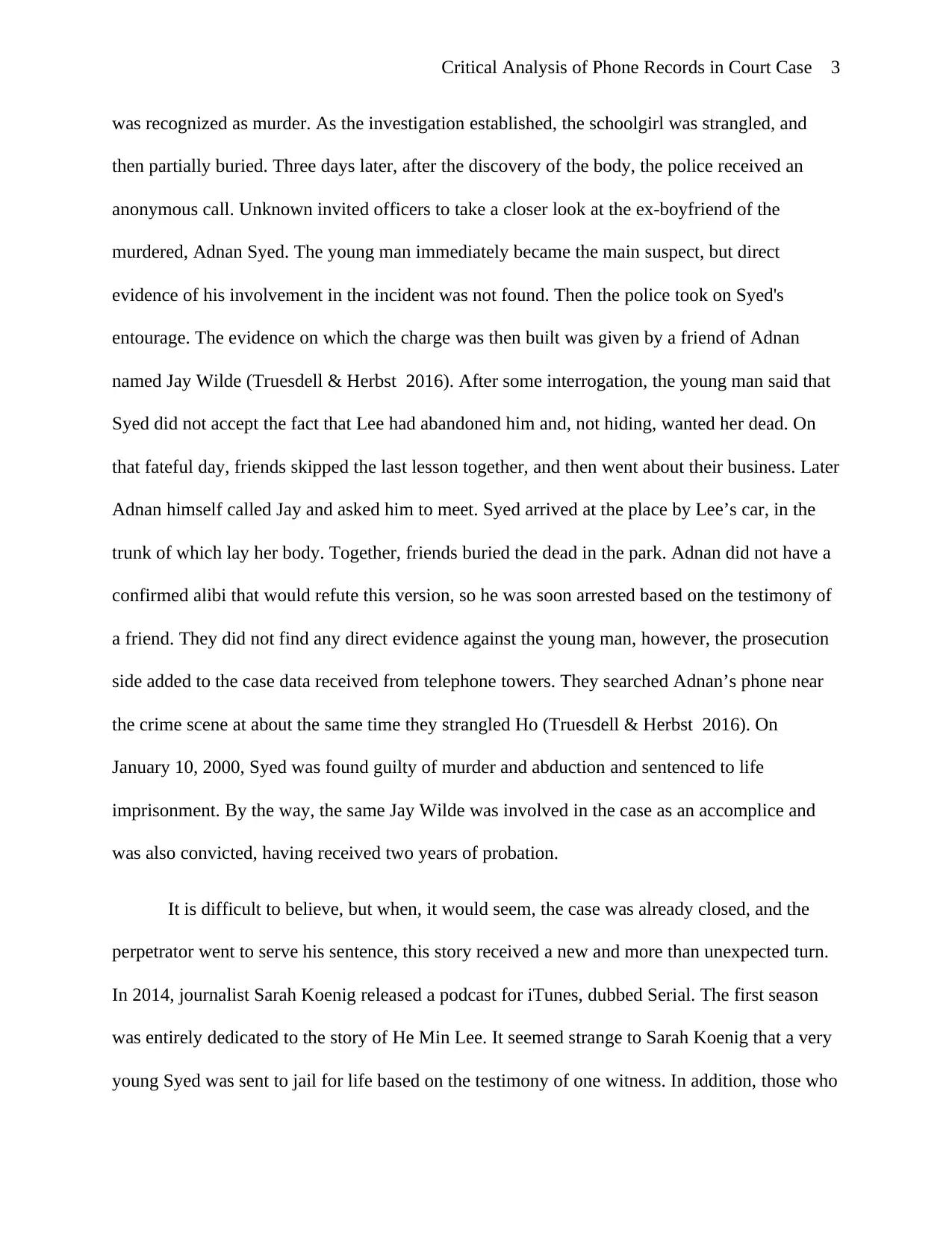
Critical Analysis of Phone Records in Court Case 3
was recognized as murder. As the investigation established, the schoolgirl was strangled, and
then partially buried. Three days later, after the discovery of the body, the police received an
anonymous call. Unknown invited officers to take a closer look at the ex-boyfriend of the
murdered, Adnan Syed. The young man immediately became the main suspect, but direct
evidence of his involvement in the incident was not found. Then the police took on Syed's
entourage. The evidence on which the charge was then built was given by a friend of Adnan
named Jay Wilde (Truesdell & Herbst 2016). After some interrogation, the young man said that
Syed did not accept the fact that Lee had abandoned him and, not hiding, wanted her dead. On
that fateful day, friends skipped the last lesson together, and then went about their business. Later
Adnan himself called Jay and asked him to meet. Syed arrived at the place by Lee’s car, in the
trunk of which lay her body. Together, friends buried the dead in the park. Adnan did not have a
confirmed alibi that would refute this version, so he was soon arrested based on the testimony of
a friend. They did not find any direct evidence against the young man, however, the prosecution
side added to the case data received from telephone towers. They searched Adnan’s phone near
the crime scene at about the same time they strangled Ho (Truesdell & Herbst 2016). On
January 10, 2000, Syed was found guilty of murder and abduction and sentenced to life
imprisonment. By the way, the same Jay Wilde was involved in the case as an accomplice and
was also convicted, having received two years of probation.
It is difficult to believe, but when, it would seem, the case was already closed, and the
perpetrator went to serve his sentence, this story received a new and more than unexpected turn.
In 2014, journalist Sarah Koenig released a podcast for iTunes, dubbed Serial. The first season
was entirely dedicated to the story of He Min Lee. It seemed strange to Sarah Koenig that a very
young Syed was sent to jail for life based on the testimony of one witness. In addition, those who
was recognized as murder. As the investigation established, the schoolgirl was strangled, and
then partially buried. Three days later, after the discovery of the body, the police received an
anonymous call. Unknown invited officers to take a closer look at the ex-boyfriend of the
murdered, Adnan Syed. The young man immediately became the main suspect, but direct
evidence of his involvement in the incident was not found. Then the police took on Syed's
entourage. The evidence on which the charge was then built was given by a friend of Adnan
named Jay Wilde (Truesdell & Herbst 2016). After some interrogation, the young man said that
Syed did not accept the fact that Lee had abandoned him and, not hiding, wanted her dead. On
that fateful day, friends skipped the last lesson together, and then went about their business. Later
Adnan himself called Jay and asked him to meet. Syed arrived at the place by Lee’s car, in the
trunk of which lay her body. Together, friends buried the dead in the park. Adnan did not have a
confirmed alibi that would refute this version, so he was soon arrested based on the testimony of
a friend. They did not find any direct evidence against the young man, however, the prosecution
side added to the case data received from telephone towers. They searched Adnan’s phone near
the crime scene at about the same time they strangled Ho (Truesdell & Herbst 2016). On
January 10, 2000, Syed was found guilty of murder and abduction and sentenced to life
imprisonment. By the way, the same Jay Wilde was involved in the case as an accomplice and
was also convicted, having received two years of probation.
It is difficult to believe, but when, it would seem, the case was already closed, and the
perpetrator went to serve his sentence, this story received a new and more than unexpected turn.
In 2014, journalist Sarah Koenig released a podcast for iTunes, dubbed Serial. The first season
was entirely dedicated to the story of He Min Lee. It seemed strange to Sarah Koenig that a very
young Syed was sent to jail for life based on the testimony of one witness. In addition, those who
⊘ This is a preview!⊘
Do you want full access?
Subscribe today to unlock all pages.

Trusted by 1+ million students worldwide
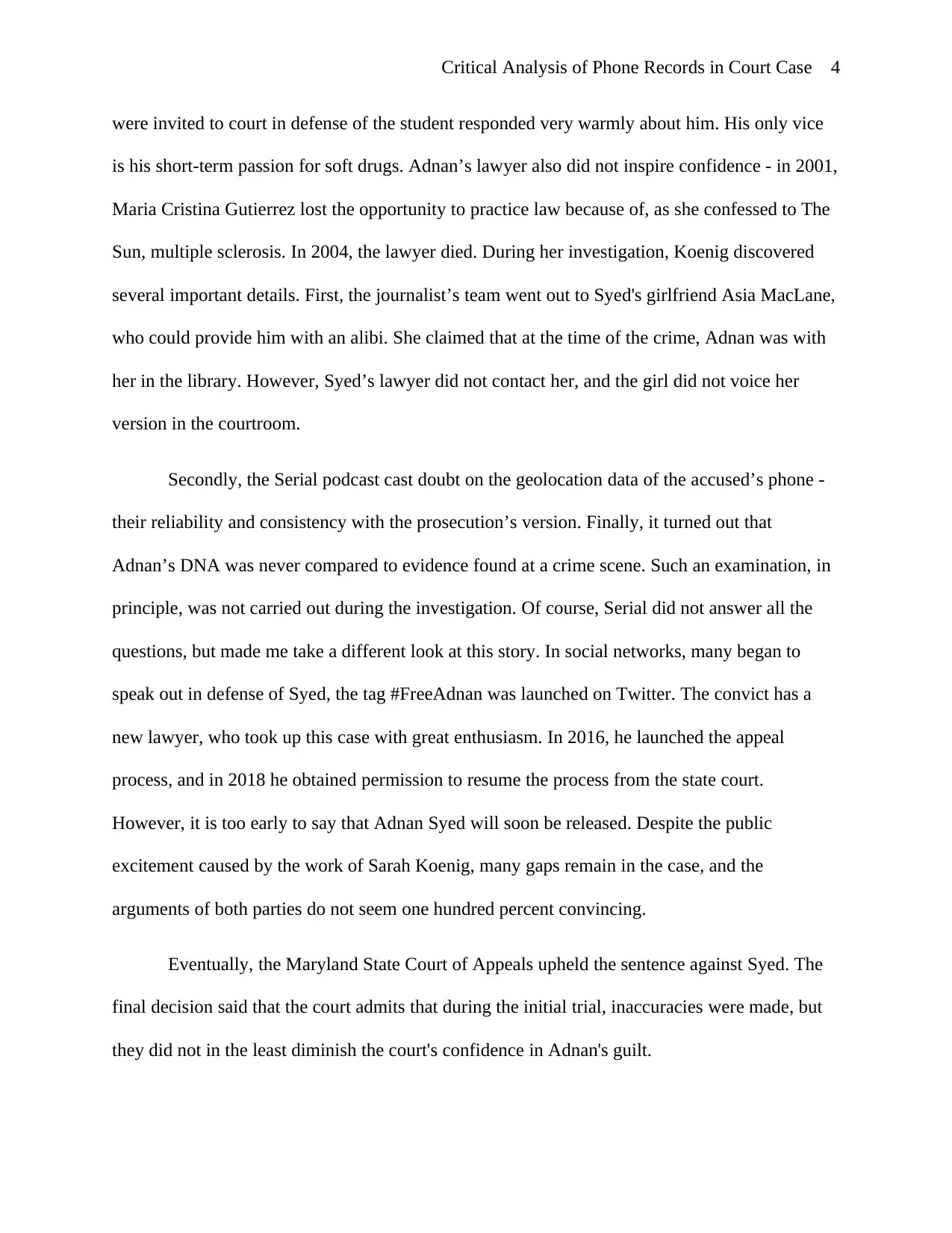
Critical Analysis of Phone Records in Court Case 4
were invited to court in defense of the student responded very warmly about him. His only vice
is his short-term passion for soft drugs. Adnan’s lawyer also did not inspire confidence - in 2001,
Maria Cristina Gutierrez lost the opportunity to practice law because of, as she confessed to The
Sun, multiple sclerosis. In 2004, the lawyer died. During her investigation, Koenig discovered
several important details. First, the journalist’s team went out to Syed's girlfriend Asia MacLane,
who could provide him with an alibi. She claimed that at the time of the crime, Adnan was with
her in the library. However, Syed’s lawyer did not contact her, and the girl did not voice her
version in the courtroom.
Secondly, the Serial podcast cast doubt on the geolocation data of the accused’s phone -
their reliability and consistency with the prosecution’s version. Finally, it turned out that
Adnan’s DNA was never compared to evidence found at a crime scene. Such an examination, in
principle, was not carried out during the investigation. Of course, Serial did not answer all the
questions, but made me take a different look at this story. In social networks, many began to
speak out in defense of Syed, the tag #FreeAdnan was launched on Twitter. The convict has a
new lawyer, who took up this case with great enthusiasm. In 2016, he launched the appeal
process, and in 2018 he obtained permission to resume the process from the state court.
However, it is too early to say that Adnan Syed will soon be released. Despite the public
excitement caused by the work of Sarah Koenig, many gaps remain in the case, and the
arguments of both parties do not seem one hundred percent convincing.
Eventually, the Maryland State Court of Appeals upheld the sentence against Syed. The
final decision said that the court admits that during the initial trial, inaccuracies were made, but
they did not in the least diminish the court's confidence in Adnan's guilt.
were invited to court in defense of the student responded very warmly about him. His only vice
is his short-term passion for soft drugs. Adnan’s lawyer also did not inspire confidence - in 2001,
Maria Cristina Gutierrez lost the opportunity to practice law because of, as she confessed to The
Sun, multiple sclerosis. In 2004, the lawyer died. During her investigation, Koenig discovered
several important details. First, the journalist’s team went out to Syed's girlfriend Asia MacLane,
who could provide him with an alibi. She claimed that at the time of the crime, Adnan was with
her in the library. However, Syed’s lawyer did not contact her, and the girl did not voice her
version in the courtroom.
Secondly, the Serial podcast cast doubt on the geolocation data of the accused’s phone -
their reliability and consistency with the prosecution’s version. Finally, it turned out that
Adnan’s DNA was never compared to evidence found at a crime scene. Such an examination, in
principle, was not carried out during the investigation. Of course, Serial did not answer all the
questions, but made me take a different look at this story. In social networks, many began to
speak out in defense of Syed, the tag #FreeAdnan was launched on Twitter. The convict has a
new lawyer, who took up this case with great enthusiasm. In 2016, he launched the appeal
process, and in 2018 he obtained permission to resume the process from the state court.
However, it is too early to say that Adnan Syed will soon be released. Despite the public
excitement caused by the work of Sarah Koenig, many gaps remain in the case, and the
arguments of both parties do not seem one hundred percent convincing.
Eventually, the Maryland State Court of Appeals upheld the sentence against Syed. The
final decision said that the court admits that during the initial trial, inaccuracies were made, but
they did not in the least diminish the court's confidence in Adnan's guilt.
Paraphrase This Document
Need a fresh take? Get an instant paraphrase of this document with our AI Paraphraser
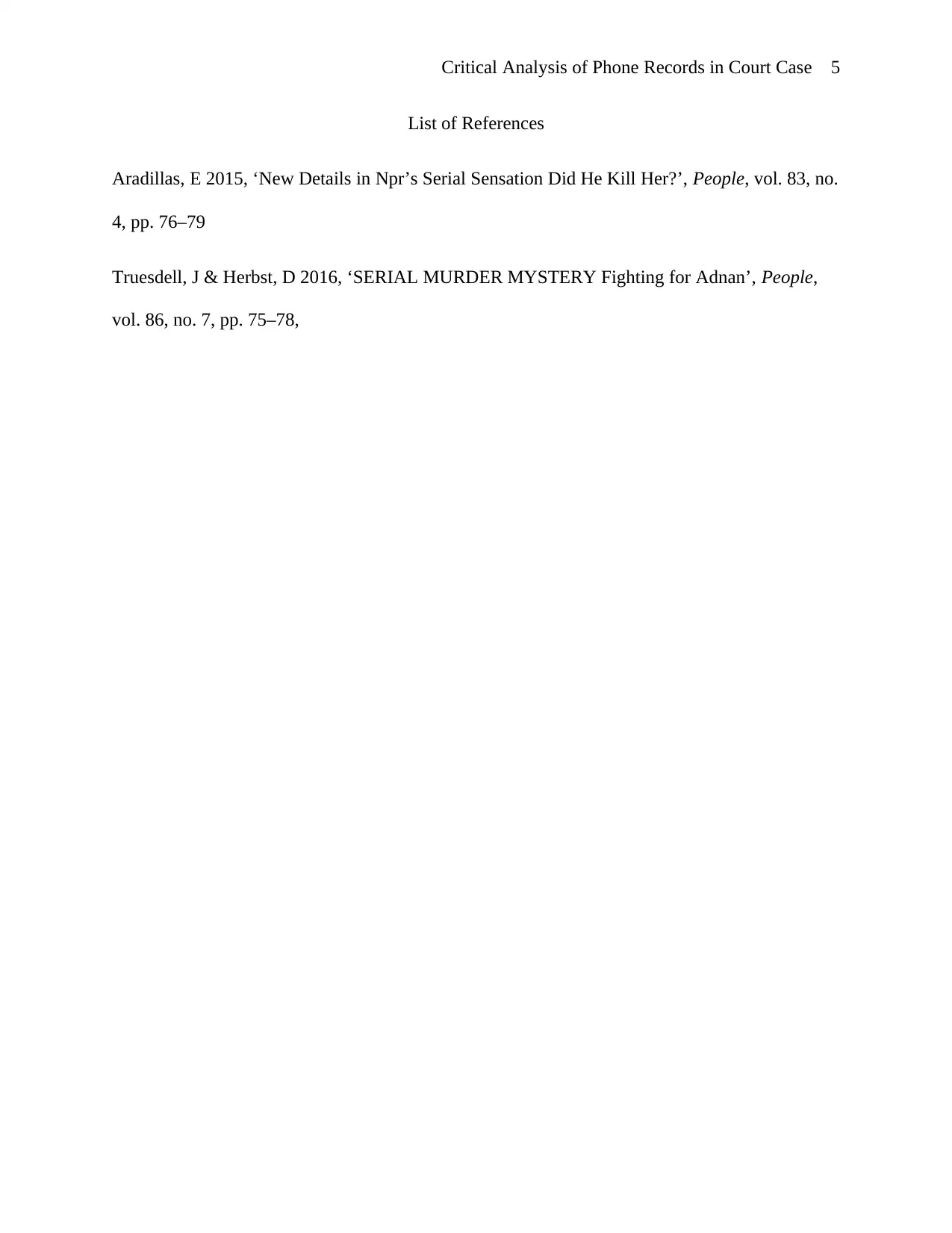
Critical Analysis of Phone Records in Court Case 5
List of References
Aradillas, E 2015, ‘New Details in Npr’s Serial Sensation Did He Kill Her?’, People, vol. 83, no.
4, pp. 76–79
Truesdell, J & Herbst, D 2016, ‘SERIAL MURDER MYSTERY Fighting for Adnan’, People,
vol. 86, no. 7, pp. 75–78,
List of References
Aradillas, E 2015, ‘New Details in Npr’s Serial Sensation Did He Kill Her?’, People, vol. 83, no.
4, pp. 76–79
Truesdell, J & Herbst, D 2016, ‘SERIAL MURDER MYSTERY Fighting for Adnan’, People,
vol. 86, no. 7, pp. 75–78,
1 out of 5
Your All-in-One AI-Powered Toolkit for Academic Success.
+13062052269
info@desklib.com
Available 24*7 on WhatsApp / Email
![[object Object]](/_next/static/media/star-bottom.7253800d.svg)
Unlock your academic potential
Copyright © 2020–2025 A2Z Services. All Rights Reserved. Developed and managed by ZUCOL.

